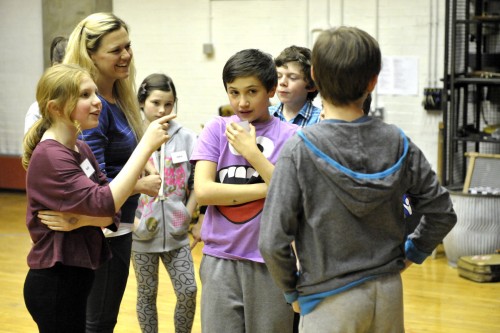Choreographer, Lucy May Hind talks to Zoe Parker (@Zoe_Parker) about her role as movement director in West Yorkshire Playhouse’s latest production of Wind in the Willows …
Zoe: How did you get started as a Movement director?
Lucy: I started as an actor and quite early on I did a show where a quite important part of the narrative needed abstract movement, so I went in and solved that. Then one thing led to another. I learnt more and more skills as I went along. My aim for 2013 is to get my stage combat qualification because many directors now want both movement and fight direction. However, you have to be qualified to work as a fight director. This project has been a joy and it’s exactly where my strengths lie.
Tell us about your approach as a movement director?
I generally prefer to choreograph in the room, working with the performers. In this production, the creative team worked together on everything, which is the ideal way to work when the movement is embedded in the narrative. One of the most important things is economy of ideas: so I encourage the actors to make one strong choice. It’s amazing how one tiny adjustment can bring the whole physicality to life. Being a performer has seriously influenced my style. It’s about trust and ownership. I like to let actors find the movement themselves and then work with them. It’s a fine balance between being in control and creating together, same as directing.
How did you go about ‘animalising’ the humans?
It was mostly about finding a world in which they could be upright human characters with the personalities of animals. We looked at structures of movement through the space, weight distribution and simple rhythms of how animals move. We definitely didn’t want crawling on all fours or for actors to ‘literally’ show that they had paws or ears. It was more about responding in an animal way. Otter is a really good example – the guy that plays Otter came up with this thing where he constantly moves his hips from side to side. It doesn’t match how otters move physiologically, but it reflects their quick and fluid path through the water. For the weasels, we went quite ‘meerkat-ish’, so they sit up and move around one another with this ‘pack mentality’.The costumes also really bring the animals to life– but we didn’t rely on this.
How did you approach working with the young cast?
I started from scratch, with little twitches and we gave them words to hang on to like with the mouse I think it was the word snitch. I liked that they were bold and not at all self-conscious. They constantly watch each other which was really useful. I have relied on the little ones a lot to fill the stage with choreography as the actors have instruments and playing complex music during some of the dance numbers. The young people impressed me: they are little but they are on you-tube all the time researching their characters, and very patient in rehearsals.
What have been the main challenges?
There are a lot scene changes in the first half, a lot of time passes: we have to fill it with enough so that you feel like the world is carrying on but not so much that we forget where we are. It’s quite a difficult balance. We are doing a lot of adapting now that we have transferred onto the set as things don’t read the same as they did in the rehearsal room. Sometimes we have to make tough choices. It’s part of my responsibility as a movement director to look after my actors. I had an actor who wanted to jump off the stage and she was perfectly capable of doing it and looked brilliant, but i had to consider that she would be doing two shows a day, for two months. If an actor comes back with an injury, that’s not good for anyone.
How does this version compare to the traditional story of Wind in the Willows?
All the traditional bits of Wind in the Willows are there: simple scenes with characters telling a story, but we wanted to make something new and be a bit risky. The design choices are really bold and it is very funny. There are several little fun ditties. My favourite one is Toad’s– there is a full marching band, Toad is messing around in the car while all the kids are dancing around the outside – very sweet. There is a moment in the choreography in the second half where the weasels come out and do a clog dance. This is quite odd but I like that, because the second half needs to keep going and be constantly surprising us.
Alan Bennett’s adapted version of Wind in the Willows, directed by Ian Brown opens at West Yorkshire Playhouse on 24th November and runs till 19th January 2013.For tickets contact the box office on 0113 213 7700 or BOOK NOW
Zoe Parker is a choreographer and dance artist who blogs about culture, dance and wellbeing. She is one part of @yorkslifeaqua a dry land synchronised swimming team coming to a water feature near you.
